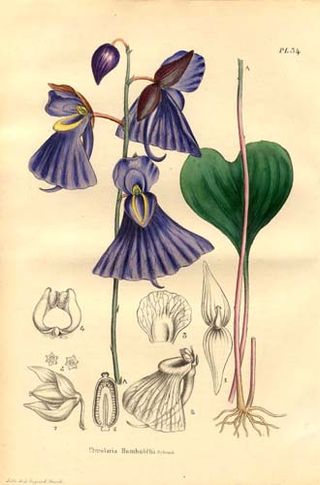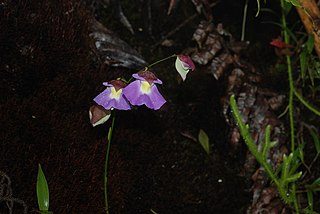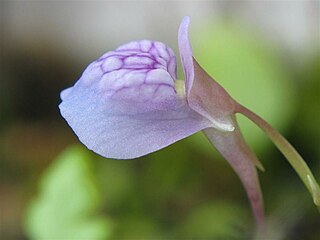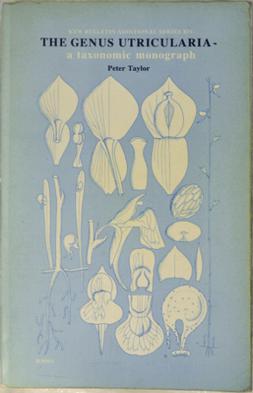
Utricularia humboldtii is a large perennial carnivorous plant that belongs to the genus Utricularia. Peter Taylor lists it as either an "aquatic-epiphyte", a subaquatic or a terrestrial species. U. humboldtii is endemic to South America, where it is found in Brazil, Guyana, and Venezuela. It was originally published and described by Robert Hermann Schomburgk in 1840. It is usually found growing in the water-filled leaf axils of some species of bromeliad, including Brocchinia micrantha, B. tatei, and B. reducta and also plants in the genus Orectanthe. It also grows as an epiphyte on tree trunks or as a subaquatic or terrestrial species in shallow water or wet soil in open savanna. It is found mostly between altitudes of 1,200 m (3,937 ft) and 2,500 m (8,202 ft), though it has been found at altitudes as low as 300 m (984 ft). It has been collected in flower throughout every month of the year.

Utricularia unifolia is a medium-sized perennial carnivorous plant that belongs to the genus Utricularia. U. unifolia is native to Central America and western South America. It was originally published and described by Hipólito Ruiz López and José Antonio Pavón Jiménez in 1797 and later considered a synonym of Utricularia alpina until Peter Taylor's 1989 monograph on the genus where he restored the species as distinct from U. alpina. It grows as a terrestrial or epiphytic plant on moss-covered trees, rocks, or banks in cloud forests at altitudes between 2,000 m (6,562 ft) and 3,000 m (9,843 ft). U. unifolia usually produces only one leaf, which is where the species epithet "unifolia" is derived from.
Utricularia podadena is a small, probably perennial, terrestrial carnivorous plant that belongs to the genus Utricularia and is the only member of Utricularia sect. Candollea. U. podadena is endemic to Malawi and Mozambique, being known only from the type location in Malawi and from one other collection in Mozambique. As of Peter Taylor's 1989 monograph on the genus, more recent efforts to locate this species have failed. It was originally published and described by Taylor in 1964 and placed in its own section, Candollea, in 1986. It grows as a terrestrial plant in marshy grasslands in the presence of Loudetia species at altitudes of around 1,000 m (3,281 ft). It flowers in July. It is a very distinct plant in the genus with the long stipitate glandular trichomes covering the flower. Its affinities within the genus are not clear.
Peter Geoffrey Taylor (1926–2011) was a British botanist who worked at Royal Botanic Gardens, Kew throughout his career in botany. Taylor was born in 1926 and joined the staff of the herbarium at Kew in 1948. He published his first new species, Utricularia pentadactyla, in 1954. In 1973, Taylor was appointed curator of the orchid division of the herbarium and, according to Kew, "under his direction, orchid taxonomy was revitalised and its horticultural contacts strengthened."
Utricularia mannii is a small, perennial, epiphytic carnivorous plant that belongs to the genus Utricularia and is the only member of Utricularia sect. Chelidon. U. mannii is endemic to tropical Africa, particularly the islands in the Gulf of Guinea and the adjacent mainland. It grows as an epiphytic plant on mossy tree trunks in rain forests at altitudes from 500 m (1,640 ft) to 2,100 m (6,890 ft). It has been collected in flower between April and November. It was originally published and described by Daniel Oliver in 1865 and placed in its own section, Chelidon, in 1986 by Peter Taylor.
Utricularia appendiculata is a medium-sized, probably perennial, terrestrial carnivorous plant that belongs to the genus Utricularia and is the only member of Utricularia sect. Oliveria. U. appendiculata is endemic to Africa, where it can be found in Burundi, Cameroon, the Central African Republic, the Democratic Republic of the Congo, Gabon, Madagascar, Malawi, Mozambique, Tanzania, Uganda, and Zimbabwe. It grows as a terrestrial plant in wet Sphagnum bogs, damp sandy savannas, or in peaty marshes at altitudes from 1,500 m (4,921 ft) to 1,860 m (6,102 ft), but as low as 700 m (2,297 ft) in the Central African Republic. It flowers mostly in the wet season. It was originally published and described by Eileen Adelaide Bruce in 1933 and was placed in its own section, Oliveria, in 1986 by Peter Taylor.

Utricularia parthenopipes is a small annual carnivorous plant that belongs to the genus Utricularia and is endemic to the Brazilian state of Bahia. It grows as a terrestrial plant in damp, sandy soils over sandstone rocks at altitudes from 500 m (1,640 ft) to 1,500 m (4,921 ft) and flowers between January and June in its native range. It was originally described and published by Peter Taylor in 1986.
Utricularia microcalyx is a small to medium-sized annual carnivorous plant that belongs to the genus Utricularia. It is native to tropical Africa, where it can be found in the Democratic Republic of the Congo and Zambia. U. microcalyx grows as a terrestrial plant in damp, sandy or peaty soils in grasslands at altitudes from 1,200 m (3,937 ft) to 1,650 m (5,413 ft). It typically flowers between February and July. It was originally described and published by Peter Taylor in 1964 as a variety of U. welwitschii. Taylor elevated this variety to the species level in 1971.
Utricularia odontosepala is a small to medium-sized, probably annual, carnivorous plant that belongs to the genus Utricularia. It is native to tropical Africa, where it can be found in the Democratic Republic of the Congo, Malawi, and Zambia. U. odontosepala grows as a terrestrial plant in damp, peaty soils in grasslands at altitudes from 1,300 m (4,265 ft) to 2,200 m (7,218 ft). It typically flowers between April and September. It was originally described and published by Otto Stapf in 1912. Peter Taylor later reduced the species to a variety of U. welwitschii in 1964 but then reversed his decision and reestablished Stapf's original treatment of the species.
Utricularia pentadactyla is a small annual carnivorous plant that belongs to the genus Utricularia. It is native to tropical Africa, where it can be found in Angola, Burundi, the Democratic Republic of the Congo, Ethiopia, Kenya, Malawi, Sudan, Tanzania, Uganda, Zambia, and Zimbabwe. U. pentadactyla grows as a terrestrial plant in damp, sandy or peaty soils in grasslands or shallow soils over rock at altitudes from 1,500 m (4,921 ft) to 2,100 m (6,890 ft). It was originally described and published by Peter Taylor in 1954, the first Utricularia species described by Taylor.
Utricularia troupinii is a small, probably annual, carnivorous plant that belongs to the genus Utricularia. It is endemic to Burundi and Rwanda. U. troupinii grows as a terrestrial plant in wet grasslands or marshes at altitudes from 1,900 m (6,234 ft) to 2,500 m (8,202 ft). It was originally described and published by Peter Taylor in 1971, but was identified in 1964 by Taylor as a possible short spurred form of U. welwitschii.
Utricularia welwitschii is a small to medium-sized, probably perennial, carnivorous plant that belongs to the genus Utricularia. It is endemic to tropical Africa, where it can be found in the Democratic Republic of the Congo, Madagascar, Malawi, South Africa, Tanzania, Zambia, and Zimbabwe. U. welwitschii grows as a terrestrial plant in sandy or peaty soils in marshy grasslands at altitudes from 1,000 m (3,281 ft) to 2,200 m (7,218 ft). It was originally described and published by Daniel Oliver in 1865. Taylor previously described two varieties of U. welwitschii, U. welwitschii var. odontosepala and U. welwitschii var. microcalyx, in 1964, but later elevated them to the rank of species as U. odontosepala and U. microcalyx, respectively. It is named in honor of Friedrich Welwitsch.

Utricularia delphinioides is a small to medium-sized, probably perennial, carnivorous plant that belongs to the genus Utricularia. It is endemic to Indochina and can be found in Cambodia, Laos, Thailand, and Vietnam. U. delphinioides grows as a terrestrial plant in swamps and rice fields, wet grasslands, or open pine forests at altitudes from near sea level to 1,300 m (4,265 ft). It was originally named by Clovis Thorel but formally described and published by François Pellegrin in 1920. A variety, U. delphinioides var. minor, was also described in 1920, but Peter Taylor reduced the variety to synonymy under U. delphinioides because he discovered a continuous range of sizes between the larger and smaller forms, size being the only distinctive characteristic in the 1920 description of the variety.

Utricularia graminifolia is a small perennial carnivorous plant that belongs to the genus Utricularia. It is native to Asia, where it can be found in Burma, China, India, Sri Lanka, and Thailand. U. graminifolia grows as a terrestrial or affixed subaquatic plant in wet soils or in marshes, usually at lower altitudes but ascending to 1,500 m (4,921 ft) in Burma. It was originally described and published by Martin Vahl in 1804. It has also recently been grown in planted aquaria. It is however not a true aquatic species, as seen in species from Utricularia subg. Utricularia.
Utricularia pobeguinii is a small annual carnivorous plant that belongs to the genus Utricularia. It is endemic to Africa and is only found in the region around Kindia, Guinea. U. pobeguinii grows as a terrestrial plant in wet soils among sandstone at altitudes from 500 m (1,640 ft) to 1,000 m (3,281 ft). It was originally described by François Pellegrin in 1914, reduced to a variety of U. spiralis by Peter Taylor in 1963, and later elevated back to the species level by Taylor upon further investigation.
Utricularia wightiana is a small to medium-sized, probably perennial carnivorous plant that belongs to the genus Utricularia. It is endemic to India and is mostly confined to Nilgiri and Kodaikanal hills of Tamil Nadu state and Attappadi hills of Kerala state of India. U. wightiana grows as a terrestrial plant in marshes and wet grasslands at altitudes from 1,000 m (3,281 ft) to 2,200 m (7,218 ft). It was originally described by Peter Taylor in 1986. It was named in honor of Robert Wight.
Utricularia christopheri is a small perennial carnivorous plant that belongs to the genus Utricularia. It is endemic to the Himalaya region and includes distributions in Sikkim, India and Nepal. U. christopheri grows as a lithophyte among bryophytes on rocks at altitudes from 3,600 m (11,811 ft) to 3,900 m (12,795 ft). It was originally described by Peter Taylor in 1986.
Utricularia pulchra is a small, probably annual, carnivorous plant that belongs to the genus Utricularia. It is endemic to New Guinea. U. pulchra grows as a lithophyte or terrestrial plant among mosses in wet sand or rocks and on wet cliffs at altitudes from 2,250 m (7,382 ft) to 3,100 m (10,171 ft). It was originally described by Peter Taylor in 1977.

Utricularia striatula is a small carnivorous plant that belongs to the genus Utricularia. It is widespread from tropical Africa to New Guinea. U. striatula grows as a lithophyte or epiphyte on wet rocks or tree trunks at altitudes from near sea level to 3,300 m (10,827 ft). It was originally described by James Edward Smith in 1819.

The Genus Utricularia: A Taxonomic Monograph is a monograph by Peter Taylor on the carnivorous plant genus Utricularia, the bladderworts. It was published in 1989 by Her Majesty's Stationery Office (HMSO) as the fourteenth entry in the Kew Bulletin Additional Series. It was reprinted for The Royal Botanic Gardens, Kew in 1994.






